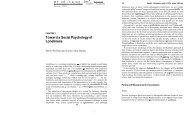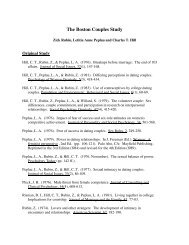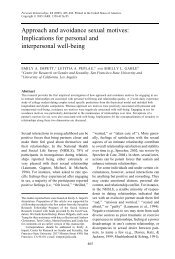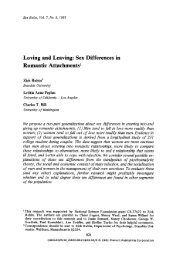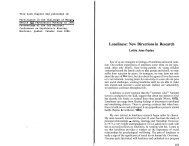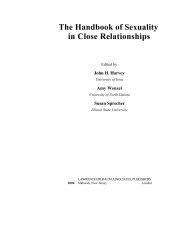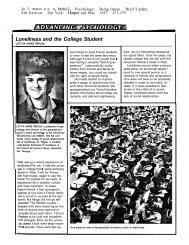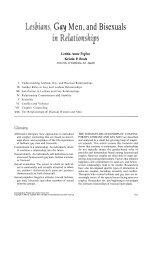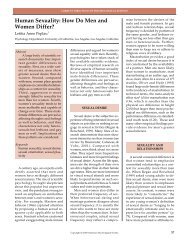"Exotic Becomes Erotic" Theory of Sexual Orientation - Anne Peplau ...
"Exotic Becomes Erotic" Theory of Sexual Orientation - Anne Peplau ...
"Exotic Becomes Erotic" Theory of Sexual Orientation - Anne Peplau ...
You also want an ePaper? Increase the reach of your titles
YUMPU automatically turns print PDFs into web optimized ePapers that Google loves.
390 THEORETICAL NOTES<br />
arousal <strong>of</strong> youth and men is strong and they experience the<br />
inseminating <strong>of</strong> boys as highly pleasurable" (Herdt & Boxer,<br />
1995, p. 76). Second, despite the extreme segregation <strong>of</strong> the<br />
sexes during childhood and adolescence, not all Sambian men<br />
are exclusively heterosexual. Bern (p. 324) acknowledges that<br />
"a tiny minority <strong>of</strong> Sambian males" do not become exclusively<br />
heterosexual, but he does not consider the implications <strong>of</strong> this<br />
fact. According to Herdt, "Somewhere less than 10% but more<br />
than 3% <strong>of</strong> all Sambian adult men continue to engage in samegender<br />
sexual behavior, even when this defies the cultural taboos<br />
and norms <strong>of</strong> their society, which require them to marry and<br />
father children" (Herdt, personal communication, May 13,<br />
1996). Some <strong>of</strong> these men are exclusively homosexual in their<br />
activities. Other men marry but "continue to enjoy oral sex<br />
with boys on the sly,'' apparently being ' 'unable to give up the<br />
pleasures <strong>of</strong> intercourse with both sexes" (Herdt & Boxer, 1995,<br />
p. 71). This rate <strong>of</strong> homosexual attraction is remarkably similar<br />
to estimates <strong>of</strong> the percentage <strong>of</strong> American men—roughly 3—<br />
8% depending on sampling and specific questions asked—who<br />
are homosexual (Harry, 1990; Laumann, Gagnon, Michael, &<br />
Michaels, 1994, pp. 296-297). In other words, even though<br />
Sambian boys were segregated to the extreme, the rate <strong>of</strong> adult<br />
male homosexuality in their culture is strikingly similar to the<br />
rate in our own culture where formal sex segregation is minimal.<br />
Contrary to EBE theory, sex segregation in childhood does not<br />
seem to determine adult sexual orientation.<br />
Importantly, anthropological reports not cited by Bern (1996)<br />
disconfirm the hypothesized link between sex segregation and<br />
sexual orientation. Using the Human Relations Area Files, Minturn,<br />
Grosse, and Haider (1969) identified 59 cultures in which<br />
information was available about adolescent sex segregation,<br />
adult attitudes toward homosexuality, and the incidence <strong>of</strong> male<br />
homosexuality in adulthood. Some cultures (like the Sambia)<br />
had virtually complete sex segregation; others permitted unchaperoned<br />
social contacts between boys and girls. Statistical<br />
analyses found no significant association between sex segregation<br />
and either adult homosexuality or attitudes toward<br />
homosexuality.<br />
In summary, the evidence marshalled by Bern (1996) to support<br />
his core proposition is unconvincing. The single study addressing<br />
childhood similarity and sexual orientation is based on<br />
retrospective reports that may well inflate differences between<br />
the reports <strong>of</strong> heterosexuals and homosexuals. Nonetheless,<br />
more than half the heterosexual women and a third <strong>of</strong> the heterosexual<br />
men reported feeling "different" in childhood. Research<br />
on familiarity and sexual orientation has also failed to support<br />
EBE theory. Survey results from the San Francisco study<br />
showed that most adults, regardless <strong>of</strong> sexual orientation, had<br />
considerable contact with same-sex peers. Bern's cross-cultural<br />
examples <strong>of</strong> childhood arranged marriage, communal childrearing<br />
on the Kibbutz, and sex segregation among the Sambia<br />
suggest that extreme patterns <strong>of</strong> contact between the sexes in<br />
childhood have remarkably little influence on adult sexual orientation.<br />
A further test <strong>of</strong> the association between sex segregation<br />
and homosexuality based on 59 cultures also failed to support<br />
EBE theory. In short, there is no reason to believe that the exoticerotic<br />
link proposed by Bern accurately describes a common<br />
developmental path to adult sexual orientation.<br />
Gender and <strong>Sexual</strong> <strong>Orientation</strong>:<br />
Does One Model Fit All?<br />
Bern (1996) makes very broad claims for his theory, asserting<br />
that it applies to both women and men and to both same-sex<br />
and opposite-sex desire. Commenting on the wide generality <strong>of</strong><br />
his theory, Bern (p. 320) notes, "In addition to finding such<br />
parsimony politically, scientifically, and aesthetically satisfying,<br />
I believe that it can also be sustained by the evidence." It would<br />
certainly be appealing to have a universal theory <strong>of</strong> sexual orientation<br />
that fits most people. However, theories that claim universality<br />
without carefully considering available research on sex<br />
differences run the risk <strong>of</strong> taking the experience <strong>of</strong> one sex<br />
(typically men) as normative and ignoring distinctive aspects<br />
<strong>of</strong> women's experiences. As Blackwood (1993, p. 301) noted,<br />
"the historical-cultural construction <strong>of</strong> homosexuality has been<br />
based predominantly on the theories <strong>of</strong> male homosexuality<br />
that have been applied to both male and female homosexual<br />
behavior." We believe that EBE theory makes this error. Two<br />
aspects <strong>of</strong> EBE theory illustrate this point: the conceptualization<br />
<strong>of</strong> erotic desire and the analysis <strong>of</strong> gender nonconformity.<br />
Erotic Desire<br />
Bern (1996) does not claim to explain all facets <strong>of</strong> sexual<br />
orientation, which would include issues <strong>of</strong> behavior, identity,<br />
and lifestyle. Rather EBE theory focuses on what Bern terms<br />
"erotic/romantic attraction." Bern does not explicitly define<br />
this key concept, but typically uses it to refer to sexual desire.<br />
Because <strong>of</strong> Bern's focus on eroticism, it is puzzling that he does<br />
not consider widely documented sex differences in erotic desire.<br />
For example, a review <strong>of</strong> research on human sexuality by Symons<br />
(1979, p. 301) concluded: "Heterosexual men tend to see<br />
women as sex objects and to desire young, beautiful women;<br />
homosexual men tend to see men as sex objects and to desire<br />
young, handsome men; but women, whether heterosexual or<br />
homosexual, are much less likely to be sexually aroused by<br />
objectified visual stimuli or to experience sexual arousal primarily<br />
on the basis <strong>of</strong> cosmetic qualities." Consistent with this view,<br />
the gay men surveyed by Bell and Weinberg (1978) emphasized<br />
their partners' physical appearance. According to these researchers<br />
(p. 92), "A chief interest which many <strong>of</strong> our [gay male]<br />
respondents had in a prospective sexual partner was the degree<br />
to which he conformed to a stereotypically 'masculine' image."<br />
Lesbians did not express similar concerns.<br />
Survey research with lesbians and gay men also documents<br />
many differences in the selection <strong>of</strong> sexual partners and the<br />
desire for sexual variety. Findings from the Bell and Weinberg<br />
(1978) study are illustrative. These gay men had many more<br />
sexual partners than did the lesbians: 75% <strong>of</strong> men reported<br />
having 100 or more sex partners compared with only 2% <strong>of</strong><br />
lesbians. Gay men <strong>of</strong>ten reported sexual encounters with strangers;<br />
lesbians typically knew their partners before having sex. As<br />
Greenberg (1995, p. 238) suggests, "When one's partner is<br />
someone whom one has never met before, for whom one feels<br />
no affection or love, and whom one never expects to see again,<br />
the subjective experience <strong>of</strong> a sexual encounter is likely to be<br />
different from what it is when one likes or loves one's partner<br />
and is in an ongoing relationship with that partner.''



